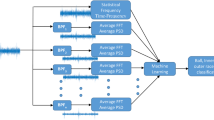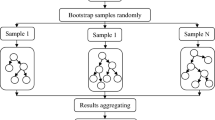Abstract
This paper describes a machine learning solution for the detection of defective embedded bearings in home appliances by sound analysis. The bearings are installed deep into the home appliances at the beginning of the production process and cannot be physically accessed once they are fully assembled. Before a home appliance is put to sale, it is turned on and passed through a sound-based sensor that produces an acoustic signal. Home appliances with defective embedded bearings are detected by analyzing such signals. The approached task is very challenging, mainly because there is a small number of sample signals and the noise level in the measurements is quite high. In fact, it is showed that the signal-to-noise ratio is high enough to mask important components when applying traditional Fourier decomposition techniques. Hence, a different approach is needed. Experimental results are reported on both laboratory and production line signals. Despite the difficulty of the task, these results are encouraging. Several classification methods were evaluated and most of them achieved acceptable performance. An interesting finding is that, among the classifiers that showed better performance, some methods are highly intuitive and easy to implement. These methods are generally preferred in industry. The proposed solution is being implemented by the company which motivated this study.







Similar content being viewed by others
Notes
Due to confidentiality clauses, the authors are not authorized to reveal the name of the company nor the home appliance under analysis.
It is emphasized that due to confidentiality clauses, the authors are not authorized to reveal further technical details about the data acquisition system.
Note that linear functions are linear in the parameters and not in the inputs, hence they can generate nonlinear decision surfaces. For instance, a Multilayer Perceptron learns linear weights yet it generates nonlinear decision surfaces, because data is projected into a higher-dimensional space.
References
Al-Raheem, K. F., Roy, A., Ramachandran, K. P., Harrison, D. K., & Grainger, S. (2009). Rolling element bearing faults diagnosis based on autocorrelation of optimized: Wavelet de-noising technique. The International Journal of Advanced Manufacturing Technology, 40, 393–402.
Benkedjouh, T,, Medjaher, K., Zerhouni, N., & Rechak, S. (2013). Health assessment and life prediction of cutting tools based on support vector regression. Journal of Intelligent Manufacturing, 1–11.
Bishop, C. (2007). Pattern recognition and machine learning (1st ed.). Berlin: Springer.
Dey, D., Solorio, T., Montes, M., & Escalante, H. J. (2011). Instance selection in text classification using the silhouette coefficient measure. Lecture Notes in Computer Science, vol. 7094, pp. 357–369.
Golub, T., Slonim, D. K., Tamayo, P., Huard, C., Gaasenbeek, M., Mesirov, J. P., et al. (1999). Molecular classification of cancer: Class discovery and class prediction by gene expression monitoring. Science, 286, 531–537.
Goumas, S., Zervakis, M. E., & Stavrakakis, G. S. (2002). Classification of washing machines vibration signals using discrete wavelet analysis for feature extraction. IEEE Transactions on Instrumentation and Measurement, 51(3), 497–508.
Guyon, I., & Elisseeff, A. (2003). An introduction to variable and feature selection. The Journal of Machine Learning Research, 3, 1157–1182.
Guyon, I., Gunn, S., Nikravesh, M., & Zadej, L. A. (Eds.). (2006). Feature extraction, foundations and applications, studies in fuzziness and soft computing (Vol. 207). Berlin: Springer.
Hall, M., Frank, E., Holmes, G., Pfahringer, B., Reutemann, P., & Witten, I. H. (2009). The WEKA data mining software: An update. SIGKDD Explorations, 11(1), 10–18.
Kankar, P., Sharma, S., & Harsha, S. (2011a). Fault diagnosis of ball bearings using machine learning methods. Expert Systems with Applications, 38, 1876–1886.
Kankar, P., Sharma, S., & Harsha, S. (2011b). Rolling element bearing fault diagnosis using wavelet transform. Neurocomputing, 74, 1638–1645.
Li, H., Lian, X., Guo, C., & Zhao, P. (2013). Investigation on early fault classification for rolling element bearing based on the optimal frequency band determination. Journal of Intelligent Manufacturing, 1–10
Li, R., Sopon, P., & He, D. (2012). Fault features extraction for bearing prognostics. Journal of Intelligent Manufacturing, 23, 313–321.
Li, Y., Billington, S., Zhang, C., Kurfess, T., Danyluk, S., & Liang, S. (1999). Dynamic prognostic prediction of defect propagation on rolling element bearings. Tribology transactions, 42(2), 385–392.
McFadden, P., & Smith, J. (1984). The vibration produced by a single point defect in a rolling element bearing. Journal of Sound and Vibration, 96(1), 69–82.
McInerny, S. A., & Dai, Y. (2003). Basic vibration signal processing for bearing fault detection. IEEE Transactions on Education, 46(1), 149–156.
Mendel, E., Mariano, L., Drago, I., Loureiro, S., Rauber, T., Varejao, F., & Batista, R. (2008). Automatic bearing fault pattern recognition using vibration signal analysis. In Proceedings of the 2008 IEEE international symposium on industrial electronics. IEEE, pp. 955–960.
Mitchell, T. M. (1997). Machine learning (1st ed.). NY: McGraw-Hill Science/Engineering/Math.
Montgomery, D. C. (2007). Introduction to statistical quality control. New York: Wiley.
Osyk, B. A., Hung, M. S., & Madey, G. R. (1994). A neural network model for fault detection in conjunction with a programmable logic controller. Journal of Intelligent Manufacturing, 5(2), 67–78.
Paonea, N., Scalisea, L., Stavrakakisb, G., & Pouliezosc, A. (1999). Fault detection for quality control of household appliances by non-invasive laser doppler technique and likelihood classifier. Measurement, 25, 237–247.
Press, W. H., Teukolsky, S. A., Vetterling, W. T., & Flannery, B. P. (2007). Numerical recipes: The art of scientific computing (3rd ed.). Cambridge: Cambridge University Press.
Samanta, B., Al Balushi, K. R., & Al Araimi, S. A. (2004). Bearing fault detection using artificial neural networks and genetic algorithm. EURASIP Journal on Applied Signal Processing, 2004, 366–377.
Sharma, V. S., Dhiman, S., Sehgal, R., & Sharma, S. K. (2008). Estimation of cutting forces and surface roughness for hard turning using neural networks. Journal of Intelligent Manufacturing, 19, 473–483.
Su, H., Chong, K. T., & Parlos, A. G. (2005). A neural network method for induction machine fault detection with vibration signal. In Proceedings of the 2005 international conference on computational science and its applications, LNCS, vol. 3481, pp. 1293–1302.
Sugumaran, V., & Ramachandran, K. (2011). Fault diagnosis of roller bearing using fuzzy classifier and histogram features with focus on automatic rule learning. Expert Systems with Applications, 38, 4901–4907.
Tandon, N., & Choudhury, A. (1999). A review of vibration and acoustic measurement methods for the detection of defects in rolling element bearings. Tribology International, 32(8), 469–480.
Van Kampen, N. G. (1981). Stochastic processes in physics and chemistry. Amsterdam: North-Holland.
Wang, Y., & Tseng, M. (2013). A nave Bayes approach to map customer requirements to product variants. Journal of Intelligent Manufacturing, 1–9.
Wu, X., Kumar, V., Quinlan, J. R., Yang, J. G. Q., McLachlan, H. M. G. J., Ng, A., et al. (2008). Top 10 algorithms in data mining. Knowledge and Information Systems, 14, 1–37.
Wuest, T., Irgens, C., & Thoben, K. D. (2014). An approach to monitoring quality in manufacturing using supervised machine learning on product state data. Journal of Intelligent Manufacturing, 25(5), 1167–1180.
Yan, R., Gao, R. X., & Chen, X. (2014). Wavelets for fault diagnosis of rotary machines: A review with applications. Signal Processing, 96, 1–15.
Yang, Y., Liao, Y., Meng, G., & Lee, J. (2011). A hybrid feature selection scheme for unsupervised learning and its application in bearing fault diagnosis. Expert Systems with Applications, 38, 11,311–11,320.
Zhang, Z., Wang, Y., & Wang, K. (2013). Fault diagnosis and prognosis using wavelet packet decomposition, fourier transform and artificial neural network. Journal of Intelligent Manufacturing, 24(6), 1213–1227.
Zhao, X., Li, M., Xu, J., & Song, G. (2011). An effective procedure exploiting unlabeled data to build monitoring system. Expert Systems with Applications, 38, 10,199–10,204.
Acknowledgments
Mario A. Saucedo-Espinosa wish to acknowledge graduate scholarships from CONACYT and FIME, UANL. Arturo Berrones acknowledges partial financial support from projects CONACYT CB-167651 and UANL-PAICYT. The authors would like to thank Mert Çorbaci for improving the redaction of this work.
Author information
Authors and Affiliations
Corresponding author
Rights and permissions
About this article
Cite this article
Saucedo-Espinosa, M.A., Escalante, H.J. & Berrones, A. Detection of defective embedded bearings by sound analysis: a machine learning approach. J Intell Manuf 28, 489–500 (2017). https://doi.org/10.1007/s10845-014-1000-x
Received:
Accepted:
Published:
Issue Date:
DOI: https://doi.org/10.1007/s10845-014-1000-x




